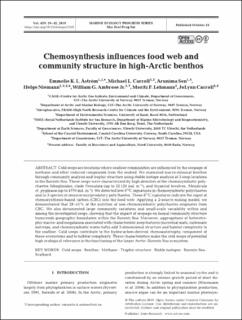| dc.contributor.author | Åström, Emmelie K. L. | |
| dc.contributor.author | Carroll, Michael L. | |
| dc.contributor.author | Sen, Arunima | |
| dc.contributor.author | Niemann, Helge | |
| dc.contributor.author | Ambrose Jr., William G. | |
| dc.contributor.author | Lehmann, Moritz F. | |
| dc.contributor.author | Carroll, JoLynn | |
| dc.date.accessioned | 2020-06-04T11:10:31Z | |
| dc.date.available | 2020-06-04T11:10:31Z | |
| dc.date.created | 2019-10-29T09:24:07Z | |
| dc.date.issued | 2019 | |
| dc.identifier.citation | Åström, E. K. L., Carroll, M. L., Sen, A., Niemann, H., Ambrose, W. G. Jr., Lehmann. M. F. & Carroll, J. (2019). Chemosynthesis influences food web and community structure in high-Arctic benthos. Marine Ecology Progress Series, 629, 19-42. doi: | en_US |
| dc.identifier.issn | 1616-1599 | |
| dc.identifier.uri | https://hdl.handle.net/11250/2656544 | |
| dc.description.abstract | Cold seeps are locations where seafloor communities are influenced by the seepage of methane and other reduced compounds from the seabed. We examined macro-infaunal benthos through community analysis and trophic structure using stable isotope analysis at 3 seep locations in the Barents Sea. These seeps were characterized by high densities of the chemosymbiotic polychaetes Siboglinidae, clade Frenulata (up to 32120 ind. m-2), and thyasirid bivalves, Mendicula cf. pygmaea (up to 4770 ind. m-2). We detected low δ13C signatures in chemosymbiotic polychaetes and in 3 species of omnivorous/predatory polychaetes. These δ13C signatures indicate the input of chemosynthesis-based carbon (CBC) into the food web. Applying a 2-source mixing model, we demonstrated that 28-41% of the nutrition of non-chemosymbiotic polychaetes originates from CBC. We also documented large community variations and small-scale variability within and among the investigated seeps, showing that the impact of seepage on faunal community structure transcends geographic boundaries within the Barents Sea. Moreover, aggregations of heterotrophic macro- and megafauna associated with characteristic seep features (microbial mats, carbonate outcrops, and chemosymbiotic worm-tufts) add 3-dimensional structure and habitat complexity to the seafloor. Cold seeps contribute to the hydrocarbon-derived chemoautotrophy component of these ecosystems and to habitat complexity. These characteristics make the cold seeps of potential high ecological relevance in the functioning of the larger Arctic-Barents Sea ecosystem | en_US |
| dc.description.abstract | Chemosynthesis influences food web and community structure in high-Arctic benthos | en_US |
| dc.language.iso | eng | en_US |
| dc.publisher | Inter-Research | en_US |
| dc.rights | Navngivelse 4.0 Internasjonal | * |
| dc.rights.uri | http://creativecommons.org/licenses/by/4.0/deed.no | * |
| dc.title | Chemosynthesis influences food web and community structure in high-Arctic benthos | en_US |
| dc.type | Peer reviewed | en_US |
| dc.type | Journal article | en_US |
| dc.description.version | publishedVersion | en_US |
| dc.rights.holder | © 2019 The Author(s) | en_US |
| dc.subject.nsi | VDP::Matematikk og Naturvitenskap: 400::Zoologiske og botaniske fag: 480::Marinbiologi: 497 | en_US |
| dc.subject.nsi | VDP::Matematikk og Naturvitenskap: 400::Zoologiske og botaniske fag: 480::Økologi: 488 | en_US |
| dc.source.pagenumber | 19-42 | en_US |
| dc.source.volume | 629 | en_US |
| dc.source.journal | Marine Ecology Progress Series | en_US |
| dc.identifier.doi | 10.3354/meps13101 | |
| dc.identifier.cristin | 1741512 | |
| dc.relation.project | The Research Council of Norway: 223259 | en_US |

